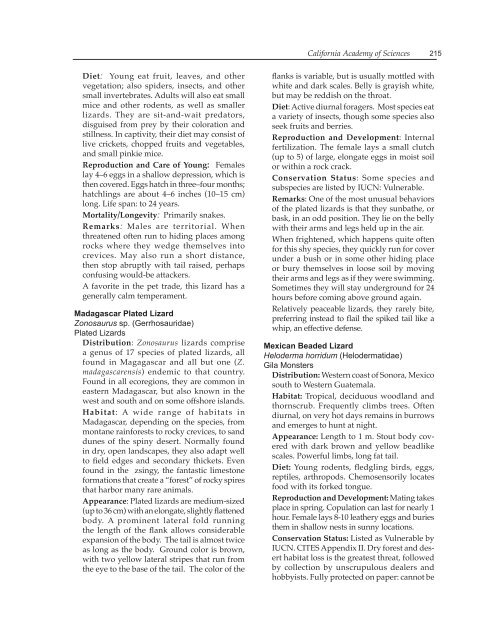THE STEINHART AQUARIUM - Gulf of Guinea Science ...
THE STEINHART AQUARIUM - Gulf of Guinea Science ...
THE STEINHART AQUARIUM - Gulf of Guinea Science ...
Create successful ePaper yourself
Turn your PDF publications into a flip-book with our unique Google optimized e-Paper software.
Diet: Young eat fruit, leaves, and other<br />
vegetation; also spiders, insects, and other<br />
small invertebrates. Adults will also eat small<br />
mice and other rodents, as well as smaller<br />
lizards. They are sit-and-wait predators,<br />
disguised from prey by their coloration and<br />
stillness. In captivity, their diet may consist <strong>of</strong><br />
live crickets, chopped fruits and vegetables,<br />
and small pinkie mice.<br />
Reproduction and Care <strong>of</strong> Young: Females<br />
lay 4–6 eggs in a shallow depression, which is<br />
then covered. Eggs hatch in three–four months;<br />
hatchlings are about 4–6 inches (10–15 cm)<br />
long. Life span: to 24 years.<br />
Mortality/Longevity: Primarily snakes.<br />
Remarks: Males are territorial. When<br />
threatened <strong>of</strong>ten run to hiding places among<br />
rocks where they wedge themselves into<br />
crevices. May also run a short distance,<br />
then stop abruptly with tail raised, perhaps<br />
confusing would-be attackers.<br />
A favorite in the pet trade, this lizard has a<br />
generally calm temperament.<br />
Madagascar Plated Lizard<br />
Zonosaurus sp. (Gerrhosauridae)<br />
Plated Lizards<br />
Distribution: Zonosaurus lizards comprise<br />
a genus <strong>of</strong> 17 species <strong>of</strong> plated lizards, all<br />
found in Magagascar and all but one (Z.<br />
madagascarensis) endemic to that country.<br />
Found in all ecoregions, they are common in<br />
eastern Madagascar, but also known in the<br />
west and south and on some <strong>of</strong>fshore islands.<br />
Habitat: A wide range <strong>of</strong> habitats in<br />
Madagascar, depending on the species, from<br />
montane rainforests to rocky crevices, to sand<br />
dunes <strong>of</strong> the spiny desert. Normally found<br />
in dry, open landscapes, they also adapt well<br />
to field edges and secondary thickets. Even<br />
found in the zsingy, the fantastic limestone<br />
formations that create a “forest” <strong>of</strong> rocky spires<br />
that harbor many rare animals.<br />
Appearance: Plated lizards are medium-sized<br />
(up to 36 cm) with an elongate, slightly flattened<br />
body. A prominent lateral fold running<br />
the length <strong>of</strong> the flank allows considerable<br />
expansion <strong>of</strong> the body. The tail is almost twice<br />
as long as the body. Ground color is brown,<br />
with two yellow lateral stripes that run from<br />
the eye to the base <strong>of</strong> the tail. The color <strong>of</strong> the<br />
California Academy <strong>of</strong> <strong>Science</strong>s<br />
flanks is variable, but is usually mottled with<br />
white and dark scales. Belly is grayish white,<br />
but may be reddish on the throat.<br />
Diet: Active diurnal foragers. Most species eat<br />
a variety <strong>of</strong> insects, though some species also<br />
seek fruits and berries.<br />
Reproduction and Development: Internal<br />
fertilization. The female lays a small clutch<br />
(up to 5) <strong>of</strong> large, elongate eggs in moist soil<br />
or within a rock crack.<br />
Conservation Status: Some species and<br />
subspecies are listed by IUCN: Vulnerable.<br />
Remarks: One <strong>of</strong> the most unusual behaviors<br />
<strong>of</strong> the plated lizards is that they sunbathe, or<br />
bask, in an odd position. They lie on the belly<br />
with their arms and legs held up in the air.<br />
When frightened, which happens quite <strong>of</strong>ten<br />
for this shy species, they quickly run for cover<br />
under a bush or in some other hiding place<br />
or bury themselves in loose soil by moving<br />
their arms and legs as if they were swimming.<br />
Sometimes they will stay underground for 24<br />
hours before coming above ground again.<br />
Relatively peaceable lizards, they rarely bite,<br />
preferring instead to flail the spiked tail like a<br />
whip, an effective defense.<br />
Mexican Beaded Lizard<br />
Heloderma horridum (Helodermatidae)<br />
Gila Monsters<br />
Distribution: Western coast <strong>of</strong> Sonora, Mexico<br />
south to Western Guatemala.<br />
Habitat: Tropical, deciduous woodland and<br />
thornscrub. Frequently climbs trees. Often<br />
diurnal, on very hot days remains in burrows<br />
and emerges to hunt at night.<br />
Appearance: Length to 1 m. Stout body covered<br />
with dark brown and yellow beadlike<br />
scales. Powerful limbs, long fat tail.<br />
Diet: Young rodents, fledgling birds, eggs,<br />
reptiles, arthropods. Chemosensorily locates<br />
food with its forked tongue.<br />
Reproduction and Development: Mating takes<br />
place in spring. Copulation can last for nearly 1<br />
hour. Female lays 8-10 leathery eggs and buries<br />
them in shallow nests in sunny locations.<br />
Conservation Status: Listed as Vulnerable by<br />
IUCN. CITES Appendix II. Dry forest and desert<br />
habitat loss is the greatest threat, followed<br />
by collection by unscrupulous dealers and<br />
hobbyists. Fully protected on paper: cannot be<br />
215


